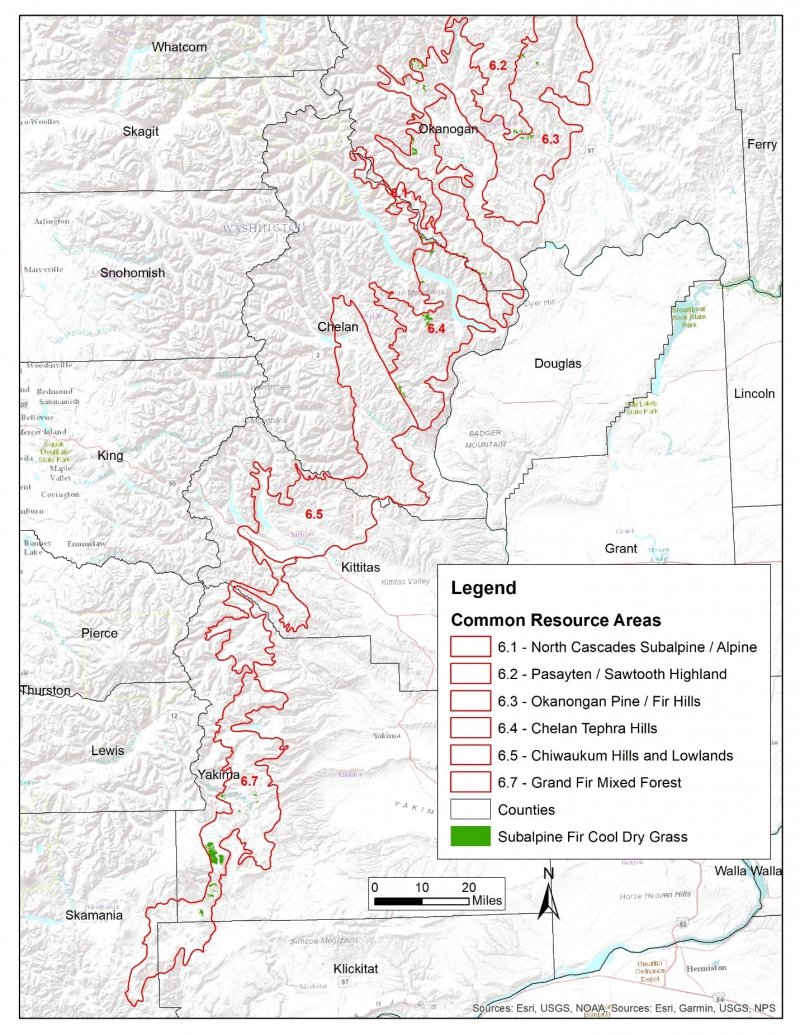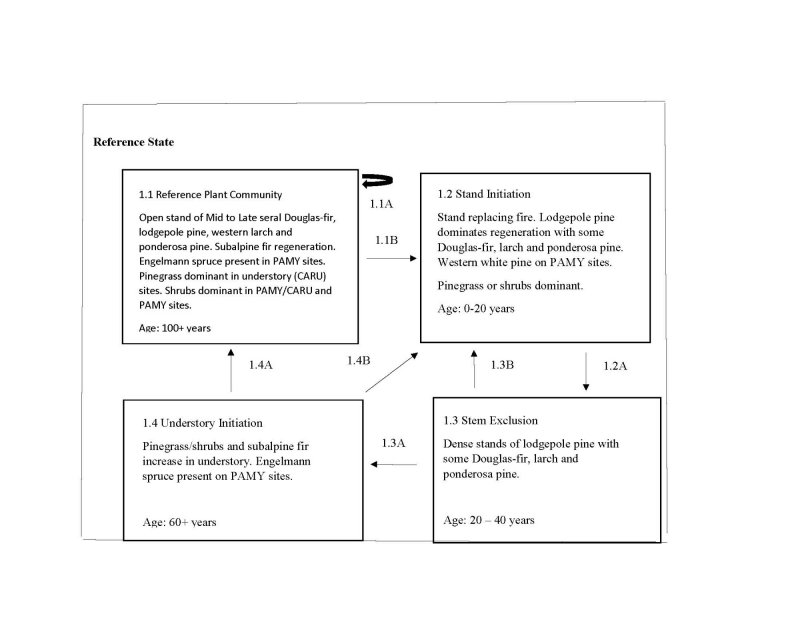
Natural Resources
Conservation Service
Ecological site F006XC001WA
Cryic Xeric Mountain Slopes and Plateaus (Subalpine fir Cool Dry Grass)
Last updated: 4/01/2025
Accessed: 12/21/2025
General information
Provisional. A provisional ecological site description has undergone quality control and quality assurance review. It contains a working state and transition model and enough information to identify the ecological site.
MLRA notes
Major Land Resource Area (MLRA): 006X–Cascade Mountains, Eastern Slope
Major Land Resource Area (MLRA): 006X–Cascade Mountains, Eastern Slope.
Stretching from northern Washington to southern Oregon, MLRA 6 encompasses the mountain slopes, foothills, elevated plateaus and valleys on the eastern slopes of the Cascade mountains. This MLRA is a transitional area between the Cascade Mountains to the west and the lower lying Columbia Basalt Plateau to the east. Situated in the rain shadow of the Cascade Crest, this MLRA receives less precipitation than portions of the cascades further west and greater precipitation than the basalt plateaus to the east. Geologically, the majority of the MLRA is dominated by Miocene volcanic rocks, while the northern portion is dominated by Pre-Cretaceous metamorphic rocks and the southern portion is blanketed with a thick mantle of ash and pumice from Mount Mazama. The soils in the MLRA dominantly have a mesic, frigid, or cryic soil temperature regime, a xeric soil moisture regime, and mixed or glassy mineralogy. They generally are moderately deep to very deep, well drained, and loamy or ashy. Biologically, the MLRA is dominated by coniferous forest, large expanses of which are dominated by ponderosa pine, Douglas-fir or lodgepole pine. Areas experiencing cooler and moister conditions include grand fir, white fir, and western larch while the highest elevations include pacific silver fir, subalpine fir and whitebark pine. Economically, timber harvest and recreation are important land uses in these forests. Historically, many of these forests would have experienced relatively frequent, low and mixed severity fire favoring the development of mature forests dominated by ponderosa pine or Douglas-fir. In the southern pumice plateau forests, less frequent, higher severity fire was common and promoted the growth of large expanses of lodgepole pine forests.
LRU notes
Common Resource Area (CRA) 6.7 - Grand Fir Mixed Forest
This LRU occurs predominantly on mountain slopes and plateaus. The soils are dominantly in the Andisols and Inceptisols taxonomic order. Soil parent materials are dominantly colluvium and residuum from igneous, sedimentary, and metamorphic rock, and glacial till, with a mantle or mixture of volcanic ash in the upper part. Taxonomic soil climate is a cryic temperature regime and xeric moisture regime with average annual precipitation of about 40 inches.
Other LRU'S where the site occurs:
CRA 6.1 - North Cascades Subalpine / Alpine
CRA 6.2 - Pasayten / Sawtooth Highland
CRA 6.3 - Okanogan Pine / Fir Hills
CRA 6.4 - Chelan Tephra Hills
Classification relationships
CEG311 (WEN); CE-G3-11 (OKAN) – Subalpine fir/pinegrass (ABLA2/CARU) (modal)
CES112 (WEN) – Subalpine fir/pachistima/pinegrass (ABLA2/PAMY/CARU)
CES113 (WEN); CE-S1-11 (OKAN) – Subalpine fir/pachistima (ABLA2/PAMY)
Ecological site concept
This is the warmest of the subalpine fir ecological sites. Most landscape locations are upper to middle slopes on warmer south to west landscapes. This site compasses three USFS plant associations: ABLA/CARU, ABLA/PAMY/CARU, and ABLA/PAMY. Its biophysical designation is Subalpine fir Cool Dry Grass. Douglas-fir, lodgepole pine, and ponderosa pine are the major seral species. Subalpine fir is the shade tolerant climax species usually found in the understory.
Associated sites
| F006XA004WA |
Cold Cryic Xeric Mountain Slopes (Subalpine fir Cold Dry Shrub) On colder, higher elevation sites. Has grouse whortleberry in the understory. |
|---|---|
| F006XA003WA |
Cryic Xeric Mountain Slopes (Subalpine fir Cool Moderately Dry Shrub/Herb) Lower elevation and warmer |
Similar sites
| F006XA001WA |
Cool Frigid Xeric Ashy Slopes (Douglas-fir Cool Dry Grass) On warmer, lower elevation sites. |
|---|---|
| F006XD002WA |
Cool Frigid Xeric Ashy Slopes (Grand fir Cool Dry Grass) On warmer, lower elevation sites. |
Table 1. Dominant plant species
| Tree |
(1) Abies lasiocarpa |
|---|---|
| Shrub |
Not specified |
| Herbaceous |
(1) Calamagrostis rubescens |
Click on box and path labels to scroll to the respective text.
Ecosystem states
State 1 submodel, plant communities
| 1.1B | - | Stand replacing fire |
|---|---|---|
| 1.2A | - | Time |
| 1.3B | - | Stand replacing fire |
| 1.3A | - | Time |
| 1.4A | - | Time |
| 1.4B | - | Stand replacing fire |

